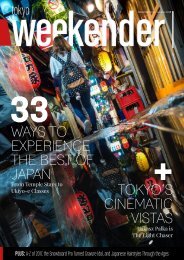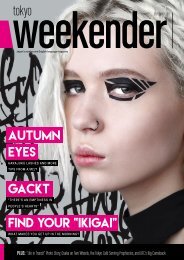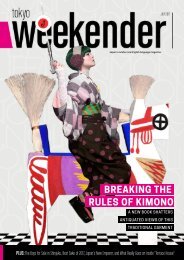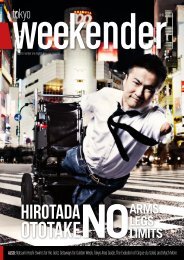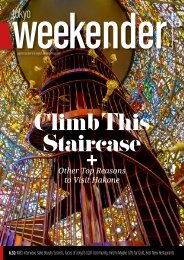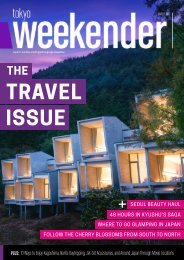Tokyo Weekender - October 2017
A day in the life of a geisha. Find your perfect Kyushu. Plus Q&A with anime director Keiichi Hara, are robots taking our jobs?, Explore Japanese cuisine at GINZA SIX, and Tsukuda guide
A day in the life of a geisha. Find your perfect Kyushu. Plus Q&A with anime director Keiichi Hara, are robots taking our jobs?, Explore Japanese cuisine at GINZA SIX, and Tsukuda guide
Create successful ePaper yourself
Turn your PDF publications into a flip-book with our unique Google optimized e-Paper software.
[ PROMOTION ]<br />
YOU’LL NEED TO BRAVE A STEEP STAIRWAY TO<br />
REACH THE TOP, BUT THE FEELING OF BEING INSIDE A<br />
PICTURESQUE OIL PAINTING IS WORTH THE EFFORT<br />
SAGA BEEF<br />
Known for being one of the best wagyu beef<br />
brands in Japan, Saga Beef benefits from the<br />
prefecture’s mild climate, pure water, and<br />
clean air. The Japanese Black cows are raised<br />
using expert breeding techniques, ensuring<br />
they do not experience any major stress. To<br />
taste this deliciously sweet and rich marbled<br />
beef, we recommend Kira, a renowned<br />
restaurant in central Saga that’s run by Japan<br />
Agricultural Cooperatives. We stopped by for<br />
lunch and ordered thin strips of Saga gyu,<br />
which we cooked ourselves on the iron plate<br />
grill in the center of the table, served with a<br />
large bowl of vegetables, salad, miso soup,<br />
rice, and pickles. Undoubtedly one of the most<br />
succulent beef dishes we’ve ever tasted. You<br />
can also order it as steak, or take a seat at the<br />
teppanyaki counter to watch the chef at work.<br />
(If you can’t make it all the way to Saga, note<br />
they also have a branch in Ginza, <strong>Tokyo</strong>.) 3-9-<br />
16 Otakara, Saga-shi, Saga. kira.saga-ja.jp/en<br />
IKIZUKURI SQUID<br />
Of course Japan in its entirety is famed for having the freshest, most delicious seafood, but if you<br />
want to experience local cuisine at its source, it’s best to visit a port town and try their speciality.<br />
In Saga, there’s one such city called Karatsu, which is famed for its port area called Yobuko. Here<br />
you should order ikizukuri – live squid that’s so live it squirms on your plate. Early risers will<br />
enjoy visiting the Yobuko Morning Market, where you can opt for dried squid should the live<br />
version be a tad too much for you. This market dates back to the early 1900s, and is considered<br />
one of the three biggest fish markets of Japan.<br />
KARATSU KUNCHI FESTIVAL<br />
This autumn matsuri is held at Karatsu Shrine<br />
and is one of Kyushu’s major festivals, dating<br />
back about 400 years and attracting 500,000<br />
visitors. What makes this festival particularly<br />
interesting is its unique hikiyama (giant floats).<br />
The first in the series of 14 was made by a<br />
woodcarving craftsman in 1819 and is called<br />
Akajishi (Red Lion float). The other 13 were all<br />
produced over the next 60 years, and feature<br />
awe-inspiring designs – probably the most<br />
unusual one is The Red Snapper, which literally<br />
looks like a fish and is meant to represent the<br />
fish markets from the old days. The floats each<br />
weigh two to five tons, and measure 4.5 to 6.8<br />
meters in height. If you can’t make it in time to<br />
see the floats being hauled along the street, or<br />
through the sand on Nishinohama Beach, you<br />
can still see them on display at the Hikiyama<br />
Exhibition Hall (6-33 Nishi-Jonai, Karatsu-shi,<br />
Saga). November 2-4, beginning at Karatsu<br />
Shrine, 3-13 Minami-Jonai, Karatsu-shi, Saga.<br />
SAGA INTERNATIONAL BALLOON FIESTA<br />
Held annually at the beginning of November, along the Kase River, this international hot air<br />
balloon competition is the largest of its kind in Asia. Boasting over 800,000 visitors every year,<br />
the event sees around 100 colorful balloons gathering and taking flight before landing several<br />
kilometers away from the fiesta grounds. There are competitive flights, which are held twice a<br />
day; the official balloons, which fly just before the main competition begins; and the Fantasia<br />
balloons, which are shaped to look like animals and cartoon characters, and are inflated every<br />
morning although they don’t actually lift off the ground. November 1-5, <strong>2017</strong>. www.sibf.jp/en<br />
TOKYO WEEKENDER | OCTOBER <strong>2017</strong> | 23



